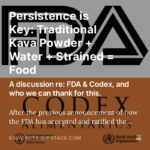A Look Into Why We Continue to See These Unfounded Kava Warnings.

Hello Kavasseurs, over the last few months I’ve been on a quest to understand why we continue to label our products with frightening warnings related to liver toxicity when we haven’t seen an adverse event involving liver damage in the last 20 years with kava products per the FDA’s own adverse event database, FAERS [1]. Despite this fact, we still observe liver warnings prominently displayed on the packaging of most kava products (though thankfully not all).
Why is this?
Let’s name the specific organization in question – The Council for Responsible Nutrition, also known as CRN. Established in 1973 and headquartered in Washington D.C., CRN is the leading trade association representing manufacturers of dietary supplements and functional foods as well as suppliers of their ingredients. Its members are dues-paying entities. According to its mission statement, CRN aims “to protect and promote an environment for our members to responsibly develop, manufacture, and market science-based dietary supplements, functional food, and their components for improved health and nutrition.” The organization heavily relies on the concept of “self-regulation” within the supplement industry and provides various recommendations to its members based on current scientific data [2].
On November 11 2014 the CRN released a memorandum to their members related to the supplements DHEA, Ephedra, and Kava [3]. Contained in this document were “Suggested elements for a Voluntary Label for Kava Products”. In this document they suggest to present the following wordage on kava product labels:
- The US FDA advises that a potential risk of rare, but severe, liver injury may be associated with kava-containing dietary supplements.
- Ask a healthcare professional before use if you have or have had liver problems, frequently use alcoholic beverages, or are taking any medication.
- Stop use and see a doctor if you develop symptoms that may signal liver problems, including jaundice (yellowing of the skin or whites of the eyes) and brown urine. Other nonspecific symptoms can include nausea, vomiting, light-colored stools, unusual tiredness, weakness, stomach or abdominal pain, and loss of appetite.
- Not for use by persons under 18 years of age, or by pregnant or breastfeeding women.
- Not for use with alcoholic beverages.
- Excessive use, or use with products that cause drowsiness, may impair your ability to operate a vehicle or heavy equipment.
The document, while making these recommendations, also includes a rather interesting and recognizable disclaimer:
- “CRN’s “Suggested Elements for a Voluntary Label for Kava Products” are based on a CRN process of scientific assessment, consultation and coordination with FDA, other trade associations, and outside scientific advisors. CRN members should understand that neither FDA, CRN, nor any other assessment has suggested that scientific evidence has established a causal relationship between kava consumption and liver problems. Thus, CRN’s recommendation is seen solely as a matter of ample prudence.”
Once again, we observe conjecture and apprehension disguised as “ample prudence” instead of recommendations grounded in scientific evidence and proven safety. While urging caution against a potentially toxic substance, they simultaneously disclaim any evidence to support such claims, which is a common feature of kava-related warnings. This kind of thinking is reminiscent of the mentality that led to the downfall of the entire industry, resulting in significant losses for those reliant on exports for financial support in the South Pacific. [4]
In essence, these suggested and voluntary warnings are founded on an unwarranted fear, rooted in flawed reports of adverse effects dating back over two decades [5]. These warnings reach back to the period between 1998 and 2004 and are not mandated by any federal or state regulations. In reality, they are unlikely to shield a seller from liability. The liver warnings on kava product labels serve no purpose other than to frighten, and to perpetuate a long-debunked myth.
[1] “FAERS Kava Adverse Reports.” September, 2022. Google Docs. Accessed November 17, 2022. https://docs.google.com/spreadsheets/d/1WP-51afXDK08VPwiotfJLQR-KIXtR_Hweky-3T_WMc0/edit?usp=sharing.
[2] “About CRN.” n.d. Accessed November 17, 2022. https://www.crnusa.org/about-crn.
[3] CRN. 2014. “CRN Safety Considerations for Dosage Recommendations and Labeling.” Council for Responsible Nutrition. https://crnusa.org/sites/default/files/pdfs/CRN-Safety-Considerations-Vol_Dosage_Labeling-Revpost2014.pdf.
[4] Gruenwald, Joerg, Cordula Mueller, and Skrabal Juergen. 2003. “In-Depth Investigation Into EU Member States Market Restrictions On Kava Products.” Centre for the Development of Entreprise.https://www.taxtyranny.ca/images/HTML/Health-Regulatory-History/Canada/Articles/kavareport.pdf
[5] Schmidt, M., and Harsewinkel. 2002. “Is Kava Really Hepatotoxic? An Analysis of the Known Data on Adverse Effects of Kava Preparations on the Liver.” http://www.fijihosting.com/dload/is_kava_really_hepatotoxic.pdf



